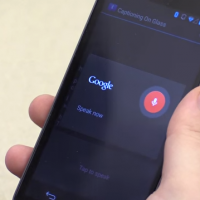Georgia Tech Researchers Use Google Glass to Help Hearing-Impaired

For a professor at the Georgia Institute of Technology, Google Glass offers possibilities that are way beyond shooting some hands-free video while skydiving. What if there were a way that a hard-of-hearing person wearing Google Glass could get real-time closed captioning to assist with the everyday conversations that most of us take for granted?
A team of researchers in Georgia Tech’s College of Computing have created speech-to-text software for Google Glass that uses a smartphone to capture a conversation. The hard of hearing person wearing Google Glass says "OK, Glass, recognize this" to start captioning. The person they are conversing with speaks into an Android smartphone, and the transcription API converts the audio to text, which is then displayed to Glass in real time.
Georgia Tech’s School of Interactive Computing Professor Jim Foley, who has difficulty hearing, demonstrates how Google Glass captions a conversation.
This system allows wearers like me to focus on the speaker’s lips and facial gestures. If hard-of-hearing people understand the speech, the conversation can continue immediately without waiting for the caption. However, if I miss a word, I can glance at the transcription, get the word or two I need and get back into the conversation.
More information and installation instructions for Captioning on Glass (CoG) are available from MyGlass. The iOS version of the CoG app is not yet available yet. Georgia Tech researchers are working with the Association of Late Deafened Adults in Atlanta to improve the program, and they welcome input.
In an early review of Google Glass, a tech reporter at The Washington Post wrote, “Wearing Google Glass in public is like wearing a sandwich-board that says ‘Talk to me!’” But for people with disabilities—hearing or vision or mobility—who are too often are left out of day-to-day conversations, Google Glass and other wearable technologies offer a way to join in.

